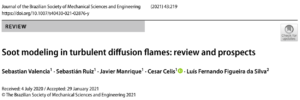
This work reviews the state of the art of the main soot modeling approaches used in turbulent diffusion flames. Accordingly, after a short introduction about the subject addressed here, the main soot formation mechanisms are described next. This description provides the basis for the discussions about the different soot modeling techniques employed nowadays for soot predictions. Since combustion and radiation models have a significant impact on soot predictions, as a consequence of the strong coupling between chemistry, turbulence and soot formation, a general overview about these models is also provided. For the sake of clarity, the main soot formation models reviewed in this work are classified as semiempirical soot precursor models and detailed ones. Both advantages and disadvantages of the referred soot modeling approaches are properly discussed. In the last part of this review, comparative results obtained using some of the main soot models currently available are presented along with a discussion about the prospects for soot modeling in turbulent flames. Finally, some conclusions and references are provided. Overall, based on the literature reviewed, it is concluded that there is yet a long path to be followed before understanding first and having then a soot model able to properly describe the formation of this critical pollutant for a variety of situations of industrial interest.
Autor(es):VALENCIA, S.
RUIZ, S.
MANRIQUE, J.
CELIS, C.
FIGUEIRA DA SILVA, L.F.
Año: 2021
Título de la revista: Journal of the Brazilian Society of Mechanical Sciences and Engineering
Volumen: 43
Url: https://doi.org/10.1007/s40430-021-02876-y
